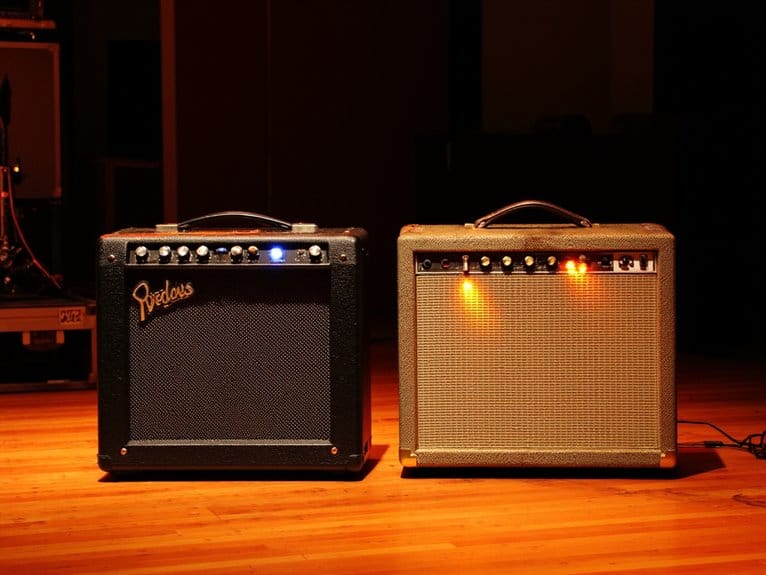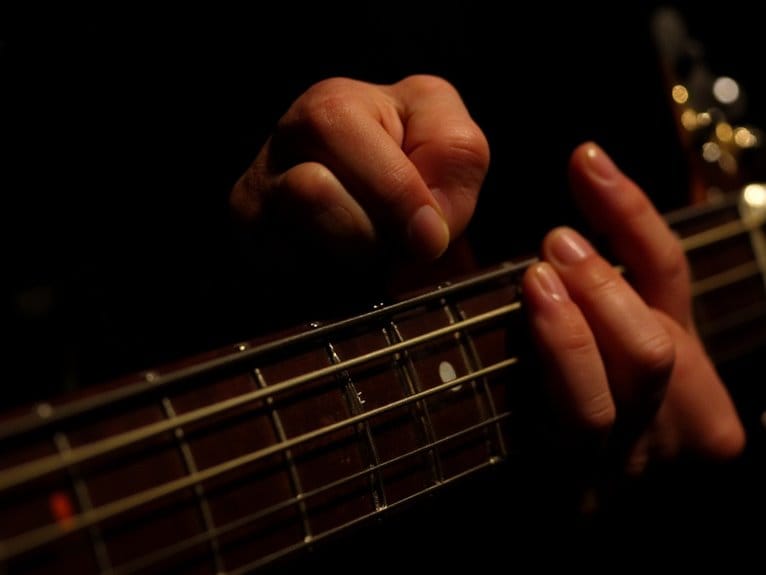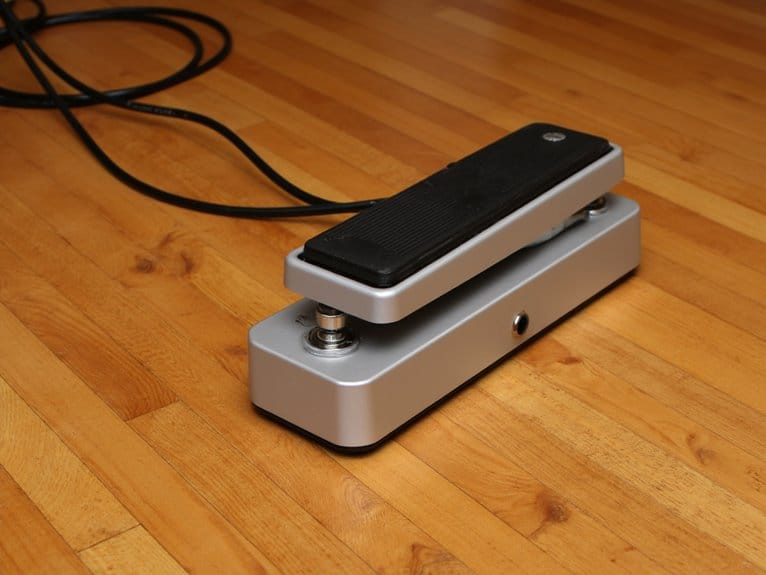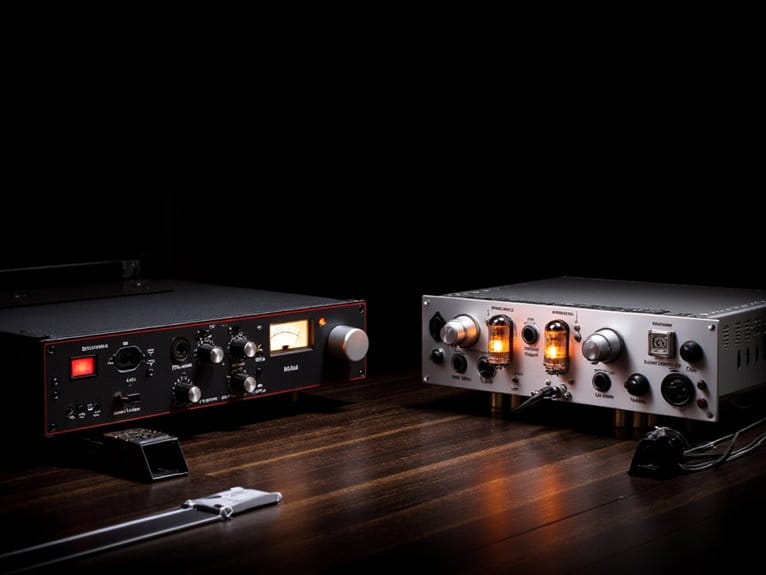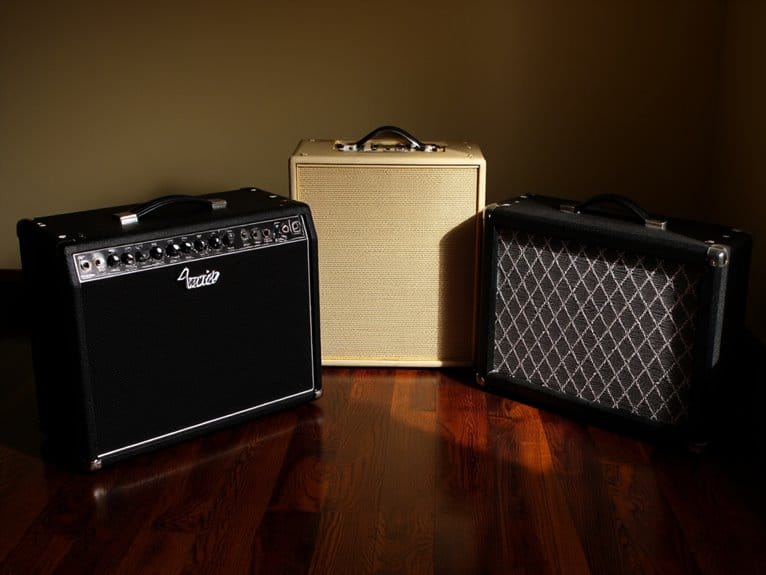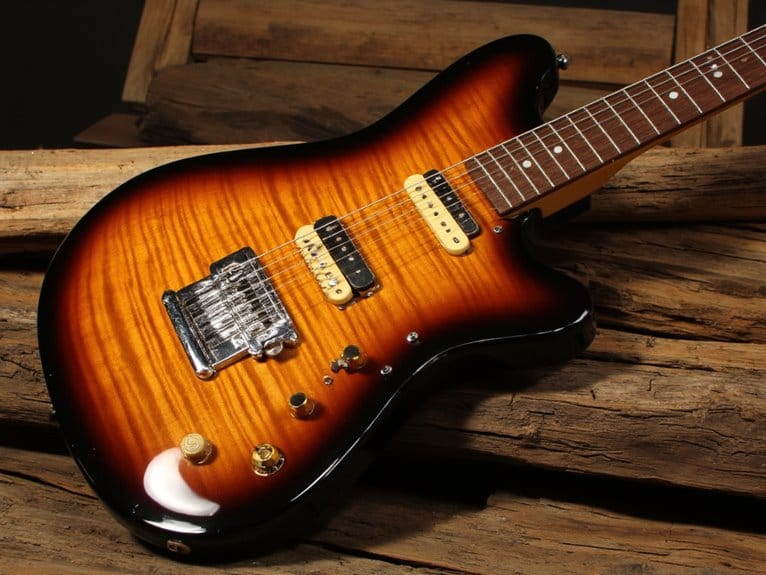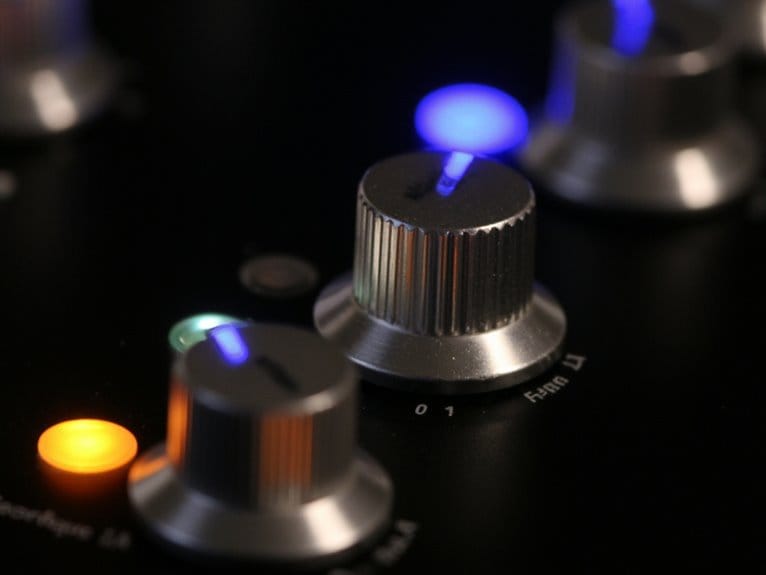Clean Guitar Amps Vs High-Gain Amps for Different Styles
You’ll want clean amps for jazz, blues, and country since they prioritize sonic clarity and natural tone through simpler preamp circuits that avoid heavy clipping. High-gain amps work best for rock and metal because they intentionally overdrive multiple preamp stages to create saturated distortion and sustain-heavy tones. Clean amps like Fender offer crystalline clarity, while high-gain circuits use multiple gain stages for compression and harmonic saturation that cuts through dense band mixes effectively.
We are supported by our audience. When you purchase through links on our site, we may earn an affiliate commission, at no extra cost for you. Learn more.
Notable Insights
- Clean amps prioritize sonic clarity and natural tone, making them ideal for jazz, blues, and country genres requiring dynamic response and articulation.
- High-gain amps create saturated distortion through multiple preamp stages, perfect for rock and metal styles needing sustained overdrive and powerful sound.
- Clean amps feature simpler preamp circuits to maintain headroom and avoid clipping, while high-gain amps intentionally drive circuits into saturation.
- Fender offers crystalline clarity, Marshall provides mid-focused thickness, and Vox delivers jangly compression for different clean tone preferences.
- Dual-channel amps provide flexibility between clean and overdrive tones, with wattage selection ranging from 10-20 watts for practice to 25-50 watts for venues.
Understanding the Core Differences Between Clean and High-Gain Amplifiers
When I first started playing guitar seriously, I’ll admit I was completely baffled by the seemingly endless debate between clean and high-gain amplifiers.
But after years of testing dozens of amps across every price range, I’ve learned that understanding their core differences comes down to how each type processes your guitar’s signal.
Clean amps prioritize sonic clarity by reproducing your guitar’s natural tone with minimal coloration, featuring simpler preamp circuits that preserve articulation and note definition. The American Clean tone exemplifies this approach, delivering the crisp, clear sound that serves as a versatile foundation for many musical styles.
High-gain amps, conversely, intentionally overdrive multiple preamp stages to create saturated distortion and sustain-heavy tones. This saturation thickens individual notes, making the playing experience significantly more engaging than clean tones alone.
The choice between these amplifier types also impacts your ability to cut through a full band mix, as higher wattage amplifiers generally produce cleaner, more defined tones that maintain clarity in loud environments.
These distinct amp profiles determine whether you’ll achieve sparkling transparency or aggressive compression, fundamentally shaping your musical expression across different genres. Many modern amplifiers include overdrive switching features that allow seamless transitions between clean and distorted tones within a single unit.
Technical Architecture: How Clean and High-Gain Amps Process Your Signal
Understanding these fundamental differences becomes much clearer when you examine what’s actually happening inside your amplifier’s circuitry, and I’ve spent countless hours with my oscilloscope analyzing signal flow to figure out why clean and high-gain amps sound so dramatically different.
Countless hours with my oscilloscope revealed the dramatic sonic differences between clean and high-gain amplifier circuits.
The preamp architecture determines everything about your amp’s character, starting with how it boosts your guitar’s weak pickup signal to line level while incorporating tone shaping circuits that control frequency response.
Here’s what happens to your signal:
- Your guitar’s signal gets amplified through op-amps or tube circuits that define the amp’s sonic personality.
- Tone stacks with adjustable potentiometers, capacitors, and resistors selectively boost or cut frequency bands.
- Clean amps maintain clarity by avoiding heavy clipping in preamp stages.
- High-gain amps intentionally drive preamp and power sections into saturation for distortion.
Modern practice amps like the Fender Mustang LT25 demonstrate this signal processing through dual channels that switch between clean and overdrive modes at the touch of a button. Quality amplifiers achieve this versatility while maintaining excellent sound quality through carefully engineered EQ controls and balanced circuitry design.
Genre-Specific Applications: Matching Amp Types to Musical Styles
Three decades of playing across different venues has taught me that musical genres aren’t just stylistic preferences—they’re sonic blueprints that demand specific amplifier characteristics, and I’ve learned the hard way that bringing a high-gain metal stack to a jazz gig creates the same awkward silence as wearing boots to a black-tie event.
Understanding genre preferences helps you match amp characteristics to your musical goals, ensuring your sound complements rather than fights against the style.
| Genre | Preferred Amp Type | Key Characteristics |
|---|---|---|
| Blues/Jazz | Clean (Fender) | Dynamic response, gentle breakup |
| Rock/Metal | High-Gain (Marshall) | Saturated overdrive, sustained tones |
| Country/Pop | Clean/Mild Drive | Clear articulation, twangy brightness |
Your amp choice should serve the music’s emotional requirements, whether that’s preserving subtle jazz nuances or delivering crushing metal aggression. For blues specifically, tube amplifiers provide the warm harmonic distortion and touch sensitivity that blues purists favor, though they require higher maintenance costs compared to solid-state alternatives. Different tube types define the sonic character of your system, with EL34 tubes offering midrange warmth ideal for blues while KT88s provide the bass and treble clarity needed for more aggressive rock styles.
Iconic Clean Amp Tones: Fender, Marshall, and Vox Characteristics
Now that you’ve identified which musical styles demand specific amplifier characteristics, you’ll want to understand how the three legendary clean amp manufacturers—Fender, Marshall, and Vox—each sculpt their distinctive sonic signatures through fundamentally different design philosophies and component choices.
Fender Cleans deliver crystalline, bell-like clarity through larger transformers and 6L6 tube types, providing exceptional headroom differences that keep your tone pristine at gig volumes.
Marshall Warmth emerges from mid-focused circuit design and EL34 tubes, breaking up earlier than Fender’s sparkling highs.
Vox Chime utilizes EL84 power tubes and smaller transformers, creating jangly, harmonically-rich compression.
- Fender’s superior EQ flexibility lets you sculpt pristine tones without muddiness
- Marshall’s thick midrange punch cuts through dense band mixes effortlessly
- Vox’s touch-sensitive dynamics respond beautifully to your playing nuances
- Speaker selection dramatically influences each brand’s harmonic character and projection
High-Gain Amp Design: Achieving Heavy Saturation and Sustain
While clean amps prioritize pristine headroom and crystalline clarity, high-gain amplifiers pursue an entirely different sonic philosophy—they’re engineered to transform your guitar’s signal into thick, saturated distortion that sustains notes far beyond what acoustic physics would normally allow.
These amps achieve heavy saturation through cascading multiple gain stages, where each preamp section pushes tubes or transistors harder, creating dense harmonic distortion. Saturation techniques include biasing components hotter and using coupling capacitors that emphasize specific frequencies for texture.
Sustain strategies involve signal compression and soft clipping in preamp stages, which smooths distortion while prolonging note decay. Master volume controls positioned after the gain stages provide essential distortion control, letting you achieve saturated tones at manageable volumes. Many high-gain amplifiers also feature built-in effects like reverb and distortion to enhance versatility and exploration of different musical genres.
High-gain designs commonly feature 12AX7 preamp tubes in multiple gain stages to maximize signal amplification before reaching the power section.
Pedal Integration Strategies for Clean Versus High-Gain Setups
When you’re building your pedalboard, the amp you choose fundamentally changes how you’ll approach your entire signal chain, from basic overdrive placement to complex modulation routing.
Clean amps give you a transparent canvas where pedals shape your core tone, while high-gain setups require strategic pedal placement to either boost the amp’s natural saturation or clean up the inherent noise that comes with cranked preamp tubes.
Understanding these differences will help you optimize your pedal order, manage your volume levels effectively, and create the exact tonal palette you’re after, whether you’re chasing pristine cleans or crushing metal tones. Just as audio recording benefits from proper signal-to-noise ratio management to minimize interference, guitar signal chains require careful attention to noise control when combining multiple gain stages.
For home practice and recording scenarios where you need cranked tube amp tones at manageable volumes, load boxes can preserve your amp’s natural character while allowing you to maintain proper pedal interaction with your preamp’s sweet spot.
Clean Amp Pedal Chains
The strategic arrangement of effects pedals represents one of the most critical decisions you’ll make when building your rig, as the signal chain order dramatically affects your tone’s clarity, dynamics, and overall character.
With clean amps, you’ve got more flexibility since you’re working with pristine headroom, but signal clarity importance becomes even more pronounced when every nuance gets amplified.
Your clean amp pedal chain should follow this hierarchy for best results:
- Tuner first – because accurate tuning with an unaffected signal prevents embarrassing moments
- Fuzz pedals immediately after – they’re temperamental and crave that pure guitar signal
- Compressors early – they need clean dynamics to work their magic effectively
- Volume pedals strategically placed – early positioning cleans up drive stages beautifully
Regular pedal maintenance tips include checking cable connections and power supplies to preserve your carefully crafted signal path. Modern multi-effects pedals can streamline your setup while offering extensive sound transformation options with multiple effect types and customizable presets.
Just as bass players benefit from professional setups to transform budget instruments into performance-ready tools, guitarists should consider professional pedal board optimization to maximize their clean amp’s potential.
High-Gain Tone Shaping
High-gain amplifiers flip the pedal integration playbook completely on its head, demanding a fundamentally different approach that prioritizes signal management, frequency shaping, and noise control over the pristine clarity we chase with clean setups.
Your high gain dynamics require distortion stacking before the preamp, where overdrive pedals push already saturated circuits into sustained territory that’ll make your neighbors question their life choices.
Tonal clarity becomes your biggest challenge when ambient effects like reverb and delay must sit at the chain’s end, preventing wash-out from excessive saturation.
Smart frequency shaping through post-distortion EQ pedals cuts muddy bass frequencies while boosting midrange presence. Wah pedals positioned before the gain stage can add vocal-like expression while the high-gain saturation enhances the sweep characteristics.
Essential pedal types include noise gates for feedback control, ensuring your signal integrity remains intact despite the controlled chaos that high-gain rigs inherently create.
Modern multi-effects pedals offer comprehensive solutions with dedicated amp modeling and extensive distortion options, allowing players to experiment with different high-gain tones without investing in multiple single-purpose pedals.
Volume Control Strategies
While clean and high-gain setups both rely on volume control for dynamic expression, I’ve learned through countless late-night practice sessions that strategic volume pedal placement can make or break your tone, requiring fundamentally different approaches that’ll either preserve your pristine clean headroom or tame your high-gain beast without sacrificing that sweet sustain.
For clean amps, placing your volume pedal early in the signal chain maintains signal purity and prevents unwanted distortion, while high-gain rigs benefit from post-distortion placement to control output without losing saturation character.
- Early placement preserves your clean amp’s headroom like a protective shield against unwanted breakup
- Post-gain control tames high-gain volume while keeping that crushing distortion intact
- Expression pedal use offers transparent parameter control without sacrificing your carefully crafted tone
- Master volume interaction requires strategic thinking to balance dynamics with your amp’s natural voice
When monitoring your volume control strategies during practice sessions, using headphones with proper impedance matching ensures you hear every nuance of your clean tones and high-gain textures without compromising your amp’s output characteristics. The Fender Champion series exemplifies this principle with their headphone output capabilities that maintain both clean and overdriven characteristics during silent practice sessions.
Practical Selection Guide: Choosing the Right Amp for Your Playing Context
When selecting between clean and high-gain amplifiers, I’ve found that your primary musical context should drive the decision more than flashy features or brand prestige.
Let your music style guide amp selection over brand names and unnecessary bells and whistles.
If you’re playing jazz, blues, or country regularly, prioritize amps with exceptional clean headroom like the Quilter Aviator Mach 3’s 200-watt output, ensuring amp compatibility with your venue requirements. Consider also the tonal versatility these amps offer, allowing you to switch between genres with ease. For those looking to delve deeper into amplifier options, guitar combo amps explained can provide useful information on various features and specifications. Ultimately, selecting the right amp can elevate your performance and enhance your overall sound.
For metal or hard rock contexts, invest in proven high-gain circuits from Mesa/Boogie or Diezel that deliver saturated distortion without muddiness.
Mixed-genre players should consider dual-channel amps offering tonal flexibility between pristine cleans and aggressive overdrive. The EL84 power tubes found in models like the Vox AC30C2 and Orange AD30HTC ensure classic British sound characteristics that work well across multiple genres.
I’ve learned that matching your amp’s core strengths to your predominant playing style, rather than chasing versatility you won’t use, yields better results and satisfaction long-term.
Consider that wattage determines versatility, with 10-20 watts suitable for home practice while 25-50 watts provide the clarity needed for larger venues and band situations.
Frequently Asked Questions
Can I Use the Same Guitar Pickups for Both Clean and High-Gain Amps?
You can use the same pickups for both amp types, but different pickup types create significant tonal differences. Low-output pickups work better for clean amps, while high-output ones excel with high-gain setups.
On a final note
You’ll find that choosing between clean and high-gain amps isn’t about right or wrong—it’s about matching your tool to your musical vision. Whether you’re chasing crystalline jazz tones through a Twin Reverb or crushing metal riffs with a Mesa Boogie, understanding each amp’s fundamental architecture, signal processing characteristics, and genre applications will guide your decision. Don’t overthink it; trust your ears and playing style.

